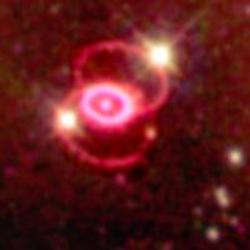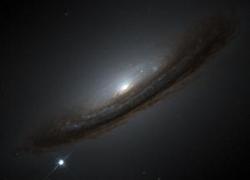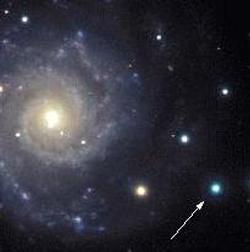 |
|
Supernova 1987A, a core-collapse supernova, exploded in 1987 in
the Large Magellanic Cloud. The image was taken by the Hubble
Space Telescope (HST) in 1999. (NASA/STScI)
|
|
 |
|
Supernova 1994D, a typical thermonuclear supernova, as seen by
HST. (High-z search team/NASA/STScI)
|
|
 |
|
Supernova 2002ap, a possible so-called hypernova which may be
linked to the production of gamma ray bursts. (Mnt. Hopkins/CfA)
|
|
|  |
Supernovae are astronomical events that almost outshine their host
galaxy for a few weeks. They are explained by explosions of stars that
either collapse under their own gravity at the end of their lives and
expel part of their mass in a huge shock wave
(core-collapse supernovae,
spectroscopically classified as types II and Ib,c), or
that ignite nuclear fusion at high densities following a long phase of
cooling and completely burn in a matter of seconds (thermonuclear, or
type Ia, supernovae).
The conference began with presentations describing the possible
progenitor stars of both classes. Progenitors of core-collapse
supernovae are stars with masses more than ten times that of our sun,
whose evolution may depend sensitively on their original chemical
composition. This allows predictions of the changing properties and
rates of these events as the universe grows older. Thermonuclear
supernovae, on the other hand, are believed to follow the extended
transfer of mass onto a white dwarf star in a binary system. Here,
too, the initial metalicity of the system can affect the mass transfer
rate, but the effect is difficult to compute in detail. Owing to the
importance of
type Ia supernovae
as cosmological standard candles, understanding the dependence of
this effect on cosmic age has gained further relevance.
On the first afternoon, the current state of theoretical modeling was
discussed. This line of work, forming one of the main research efforts
at the MPA, requires enormous computational resources on
high-performance computers in order to recreate the final few seconds
of an exploding star. In the case of core-collapse supernovae, an
accurate description of the interaction of neutrinos born in the core
with the stellar material further outside is of utmost
importance. Much progress was made in this field during the last year
but it is still unclear whether the current generation of models
predicts successful explosions. The modeling of thermonuclear
supernovae has seen some progress, as well; three-dimensional
simulations of exploding white dwarfs are currently being carried out at the
MPA.
The second day focussed primarily on the observations. Supernovae are
observed in all available spectral bands ranging from
infrared to ultraviolet, and with increasingly tight temporal
coverage. The talks emphasized the similarities and correlations
within the classes as well as the sometimes surprising differences of
important details. The challenges of the upcoming supernova-surveys at
large cosmological distances were also mentioned.
One of the topics of the third day was the impact of supernovae on the
chemical evolution of galaxies. Here, statistical models can be
compared with the observed spectra of extremely metal-poor stars where
traces of the earliest supernovae can be found, and with meteoritic
abundances from the time the solar system was formed. The end of the
conference saw a discussion of the perhaps most impressive cosmic
explosions, the so-called gamma-ray bursts. One of the most promising
models is preliminarily termed ``hypernova'' and looks in some
respects like a peculiar type Ib,c supernova. It
includes a jet, streaming out from nearby a newly formed black hole
with a velocity close to the speed of light, piercing through the
shell of a collapsing star and transforming its kinetic energy into
gamma rays later on. It was described what these events would look
like to observers with different inclinations relative to the jet
axis. There are indications that such phenomena have already been
observed.
Jens Niemeyer
|